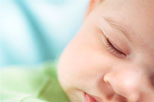Heads Up: Prevent Shaken Baby Syndrome
SBS: It's not just a crime, it's a public health issue.
What is a Shaken Baby Syndrome?
Shaken Baby Syndrome (SBS), a form of abusive head trauma (AHT) and inflicted traumatic brain injury (ITBI), is a preventable and severe form of physical child abuse. It results from violently shaking an infant by the shoulders, arms, or legs. SBS may result from both shaking alone or from impact (with or without shaking).1 The resulting whiplash effect can cause bleeding within the brain or the eyes.2
Nearly all victims of SBS suffer serious health consequences and at least one of every four babies who are violently shaken dies from this form of child maltreatment.
Know the Facts about SBS:

- SBS is a leading cause of child abuse deaths in the United States.
- Babies (newborn to 4 months) are at greatest risk of injury from shaking.
- Inconsolable crying is a primary trigger for shaking a baby.1
How Can SBS Be Prevented?
Research shows that shaking most often results from crying or other factors that may trigger the person caring for the baby to become frustrated or angry.
The fact is that crying—including long bouts of inconsolable crying—is normal developmental behavior in infants. The problem is not the crying; however, it’s how caregivers respond to it. Picking up a baby and shaking, throwing, hitting, or hurting him/her is never an appropriate response.
 Everyone, from caregivers to bystanders, can do something to prevent SBS. Giving parents and caregivers tools to know how they can cope if they find themselves becoming frustrated are important components of any SBS prevention initiative.
Everyone, from caregivers to bystanders, can do something to prevent SBS. Giving parents and caregivers tools to know how they can cope if they find themselves becoming frustrated are important components of any SBS prevention initiative.
You can play a key role in reinforcing prevention through helping people understand the dangers of violently shaking a baby, the risk factors and the triggers for it, and ways to lessen the load on stressed out parents and caregivers. All of which may help to reduce the number of children impacted by SBS.
Where Can I Find Additional Resources?
Shaken Baby Syndrome Initiative Educational Tools and Resources
New study: "Characteristics of non-fatal abusive head trauma among children in the USA, 2003–2008: application of the CDC operational case definition to national hospital inpatient data." Also available as PDF [169 KB]
CDC/Medscape Expert Commentary: Shaken Baby Syndrome: Making the Diagnosis
Sandra P. Alexander, M.Ed
View the video
(Free login required through Medscape to view the video)
Preventing Shaken Baby Syndrome: Guide for Health Departments and Community Based Organizations
The purpose of this guide is to help your organization identify your role and to take action to protect infants from SBS. It outlines steps to implement evidence-based intervention strategies, to integrate specific education messages into existing programs for new parents, caregivers, professionals, and the general public, and to engage in activities that impact policy development that is effective in preventing SBS.
Together with local and national partners, your organization can make a difference in preventing SBS, so that all children can have safe, stable, and nurturing relationships and a better chance to live to their full potential.
Further, this guide provides details on helping you get started and putting prevention strategies into actionable steps:
 Building a Framework for Prevention
Building a Framework for Prevention- Getting the Message Out
- Building Partnerships
- Impacting Policy
- Download a free copy of the guide [PDF 2.5MB]
Journalists Guide to Shaken Baby Syndrome: A Preventable Tragedy
The purpose of this guide is to give journalists and other media professionals access to the pertinent background and resources needed in order to effectively cover the story of SBS as a public health issue. Writing a story on SBS can also help to emphasize that everyone can play a role in preventing SBS. Significantly, coverage of SBS as a public health issue in the news media may foster better understanding of SBS and its triggers. This guide also:
 Provides tips for coping with a crying baby for parents and caregivers;
Provides tips for coping with a crying baby for parents and caregivers;- Reinforces that crying is a normal part of infant development and it will get better; and
- Educates parents and caregivers on how to calm themselves if they find they are frustrated or being pushed to the limit by a crying baby.
- Download a free copy of the guide [PDF 733KB]
- Watch the Video in English and Spanish
 (11 minutes)
(11 minutes)
Downloadable PSAs:
- Radio PSAs focused on parents and caregivers (in English and Spanish)
References
- Carbaugh, S.F., Understanding Shaken Baby Syndrome. Advances in Neonatal Care. 4(2): 105-116, 2004.
- Centers for Disease Control and Prevention, National Center for Injury Prevention and Control, Division of Violence Prevention. Shaken Baby Syndrome Tip Sheet. Accessed at: http://www.cdc.gov/healthmarketing/entertainment_education/tips/shaken_baby.htm.
Contact Us:
- Centers for Disease Control and Prevention
National Center for Injury Prevention and Control (NCIPC)
4770 Buford Hwy, NE
MS F-63
Atlanta, GA 30341-3717 - 800-CDC-INFO
(800-232-4636)
TTY: (888) 232-6348
24 Hours/Every Day - cdcinfo@cdc.gov


